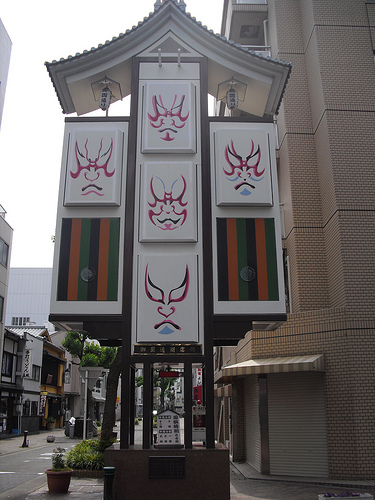Difference between revisions of "Kumadori"
From SamuraiWiki
Jump to navigationJump to search (port over from Wikipedia) |
(image) |
||
| (One intermediate revision by one other user not shown) | |||
| Line 1: | Line 1: | ||
| + | [[Image:Kumadori-Misonoza.jpg|right|thumb|375px|Some famous ''kumadori'' patterns, on display outside the [[Misono-za]] [[kabuki]] theatre in [[Nagoya]].]] | ||
*Japanese: 隈取 ''(kumadori)'' | *Japanese: 隈取 ''(kumadori)'' | ||
| Line 21: | Line 22: | ||
*[http://www.glopac.org/Jparc/CosMask/kumadori.html Makeup for individual hero roles (Image)]] | *[http://www.glopac.org/Jparc/CosMask/kumadori.html Makeup for individual hero roles (Image)]] | ||
| − | [[Category: | + | [[Category:Poetry and Theater]] |
Latest revision as of 01:40, 30 December 2011
- Japanese: 隈取 (kumadori)
Kumadori is stage makeup worn by kabuki actors, particularly when performing in the bold and bombastic aragoto style. Kumadori makeup generally consists of brightly colored stripes or patterns over a white foundation, the colors and patterns symbolizing aspects of the actor's character. Though kumadori was originated and developed extensively by members of the Ichikawa Danjûrô line of actors, some conventions are creations of the Onoe Kikugorô line.
- Bright red stripes indicate a powerful hero role. The most famous of these roles, and the one which has come to stereotypically represent kabuki in the West is the hero of Shibaraku. Red symbolizes virtue and power.
- Villains are often depicted with a design of black beard, purple veins, and dark blue antler-like eyebrows.
- Blue makeup can represent a ghost, spirit, or other magical creature, depending on the patterns. Kitsune such as Genkurô in Yoshitsune Senbon Zakura wear blue makeup. Blue represents negative emotions such as jealousy or fear; ghosts in traditional Japanese drama are often trapped by their attachment to such emotions.
- Greys and browns can be used sometimes, particularly when representing animals, oni (demons), yôkai (monsters), or anything else inhuman. One example is the tsuchigumo (ground spider) fought by Minamoto no Raikô.
The term also applies to a painting method in which two brushes are used simultaneously, one for the color and the other used to create shading or other details.
References
- This article was written by User:LordAmeth and contributed to both S-A and Wikipedia; the author gives permission for his work to be used in this way.
- Kumadori at Kabuki-Jiten (Japanese)
- Kincaid, Zoe (1925). Kabuki: The Popular Stage of Japan. London: MacMillan and Co.
